When you don't have time to marinate salmon ahead of time, brush on this simple, slightly spicy, sweet, and savory glaze for an easy taste of Hawaiian bbq at home. Get this recipe for Hawaiian salmon from Chef Roy Yamaguchi to make in the air fryer or regular oven.

This recipe works well anytime of the year, whether for a summer bbq or a quick winter weeknight meal for the air fryer.
You could pair with the classic Hawaiian condiment lomi salmon for a salmon dinner duo. For a rainbow meal, you could serve with purple potatoes, broccoli, and pineapple wedges.
Jump to:
Why You'll Like this Recipe
- You don't need to marinate the salmon far ahead of time. Just stick it on the fish and bake.
- There's so much flavor in the sauce. Serve with rice or steamed vegetable of your choice and call it a day/dinner.
- This recipe is adapted from Roy Yamaguchi, the renowned chef of Roy's restaurants, an upscale Hawiian restaurant chain. The recipe isbook, Hawaii Cooks.
Ingredients
Salmon is a strong, richly flavored fish. It requires bold flavors or buttery, thick sauces like hollandaise. This dairy free glaze packs in a combination of classic Asian fermented sauces and aromatics used in Korean and Chinese cuisines.
The combination of flavors typically used in Korean and Chinese cuisines individually also make this a Hawaiian recipe, where Asian, European, and Polynesian influences have blended to form Pacific Rim cuisine.

- Salmon - There is a pecking order to salmon with wild king, aptly named, at the top. Atlantic farmed salmon is the most commonly available (i.e. that means at Costco), while chum or pink salmon is at the lowly bottom and usually found in cans. Coho is a step above chum, but it doesn't have as much fat as Atlantic or King, so I would avoid coho if possible.
- Gochujang - This spicy Korean fermented chili paste is loaded with spicy, sweet, and salty flavor. A little does go a long way. It's typically used to season pork or squid stir fries or serves as the base of the finishing sauce for bibimbap rice bowls or crudite dip.
- Hoisin - Almost like a Chinese version of bbq sauce, it is made with fermented soybean paste, sugar, vinegar, and garlic. It is traditionally used to season meat dishes or acts as a dipping sauce for dishes like peking duck pancakes.
- Sugar (not pictured) - There is sugar in the gochujang and hoisin sauce, but additional sugar is needed to balance out the chili and salt.
- Soy Sauce - Adds saltiness and helps thin out the glaze.
- Ginger - For freshness and punchiness.
- Garlic - This aromatic root vegetable harmonizes all the flavors together with an earthy note.
You might notice there is no oil, additional fat, or salt. There is plenty of fat in the salmom and salt in the sauces already that you don't need to add anymore.
See recipe card for quantities.
Instructions
These instructions are for an air fryer, but you can also easily adapt this to the oven. See the recipe card for oven directions.
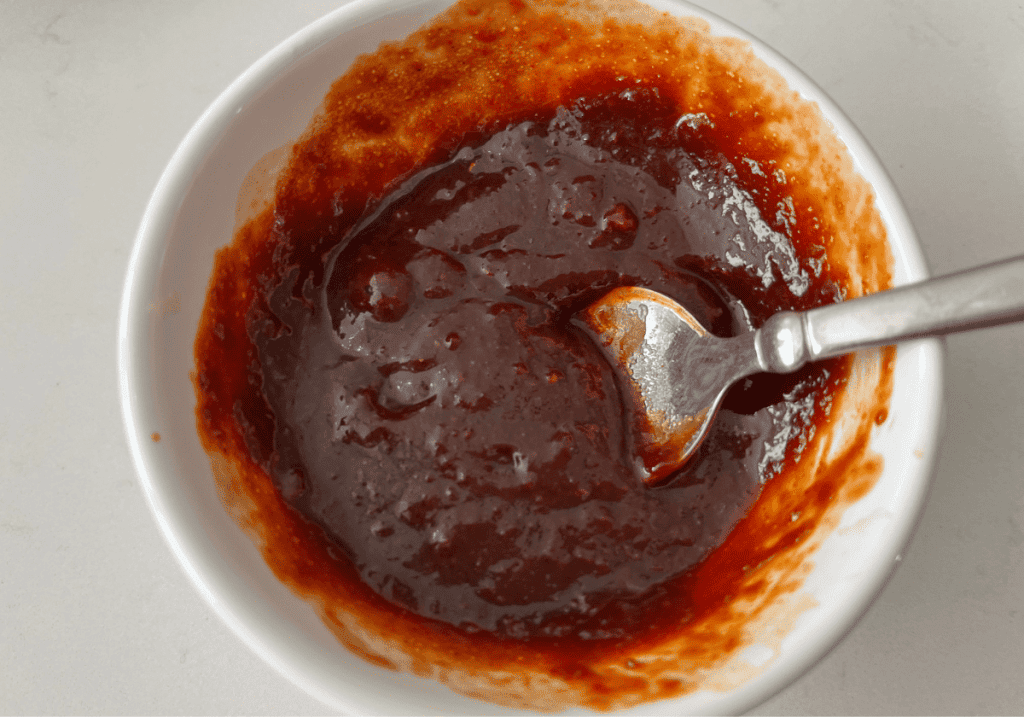
Combine all the glaze ingredients in a small bowl.

Spread the glaze all over the top of deboned salmon fillets, placed skin side down. If you have time, let it marinate at room temperature for 20 minutes.

Place the fillets in the air fryer, skin side down. Use a parchment liner if you prefer for easy cleanup.

Air fry at 325 degrees F for 12-15 minutes. The time will vary according to how thick the salmon fillets are. A general rule of thumb is 10 minutes in the oven for every inch of thickness, measured from the skin side to the top of the fillet.
Hint: Even though the salmon might look dry after it's cooked, salmon is a fatty fish and one of the highest sources of Omega-3 fatty acids. As long as the salmon is not overcoooked, it won't be dry.

Substitutions
This recipe was made for salmon, but you could use a lot of other things besides salmon with this versatile Hawaiian glaze.
- Tofu - Slice firm or extra firm tofu, and press dry with paper towels to remove extra moisture.
- Oily Fish - Instead of salmon, you can try this recipe with mackerel, tuna, steelhead trout, or swordfish.
- Vegetables - You can also use this glaze on vegetables like canned jackfruit, cauliflower steaks, or even broccoli steaks.
Variations
- Spicy - Mix in some minced jalapenos or add a squeeze of sriracha sauce if you want to amp up the heat.
- Deluxe - Splurge and use king salmon, the fattiest, richest salmon of them all. This intense glaze cuts through all the buttery layers of Omega-3 fatty acids for a really nice flavor contrast.
- Furikake - For extra umaminess and salty sweetness, top with furikake, the Japanese all purpose wonder seasoning.
Equipment
Besides an air fryer, the parchment paper liners that fit right into the air fryer basket really help with easy cleanup.
The liners block air flow from flowing underneath the salmon, but this recipe is not about obtaining crispy skinned salmon.
If you need an air fryer, check out these best tips before buying an air fryer.
Storage
Once the salmon is cooked, store up to three days in the fridge. It tastes great cold out of the fridge, or you can even reheat it in the air fryer.
You could freeze it once cooked, but this dish comes together quickly enough that you really don't need a lot of lead time to make it again.
Top tips
- This recipe works well with all types of salmon from wild king, farmed Atlantic, and Coho salmon. This would work on a side of salmon, portioned fillets, or steak cut salmon.
- Because of the sugar in the glaze, and the air fryer gets so hot, it can burn easily if overcooked. Take care to check on the salmon as its cooking to prevent it from getting too dark.

FAQ
No, salmon came to Hawaii via sailors from the Pacific Northwest in the 19th century.
Use a parchment paper liner or spray the basked with a little bit of cooking oil with a high smoke point such as avocado, canola, or grapeseed oil
A container of gochujang has so much salt and sugar, it can last for years without spoiling. The problem though is that it dries out and loses its bright red color. Once opened, keep the container in the refrigerator and plan to use within a few months if possible.
Related
Looking for other seafood recipes? Try these:
Pairing
Try other Hawaiian dishes to serve with this salmon:
Recipe
Hawaiian Salmon with Gochujang
Ingredients
- 1 ½ lb salmon fillets with or without skin, preferably deboned, see Note 1
Glaze
- 2 Tb gochujang Korean chili paste
- 2 Tb hoisin sauce
- 2 Tb soy sauce
- 2 teaspoon sugar
- 1 teaspoon garlic minced
- 1 teaspoon ginger minced
Optional garnishes
- sliced green onion
- toasted sesame seeds
Instructions
- Place salmon fillets skin side down in the air fryer using a parchment paper liner or spray the basket with oil so the skin doesn't stick to it. If using an oven, preheat oven to 350 degrees F. Place salmon fillets skin side down onto a parchment lined baking sheet or spray the baking sheet with oil.
- Mix together glaze ingredients. Spread onto the salmon. Let sit for 20 minutes at room temperature, if you have time, to let the glaze seep into the salmon.
- Put salmon into the air fryer. Set to 325 degrees and cook for 10-15 minutes, depending on the thickness of the fillet. Check after 10 minutes to make sure the glaze isn't burning. For the oven, cook at 350 degrees for 10-15 minutes. A general rule of thumb is to cook salmon for 10 minutes per inch of thickness, measured vertically from the skin side up. Salmon should be cooked to an internal temperature of 145 degrees F for well done or 125 degrees F for medium rare.
- Top with optional garnishes, and serve.
Notes
- This recipe works well with all types of salmon from wild king, farmed Atlantic, and Coho salmon. This would work on a side of salmon, portioned fillets, or steak cut salmon.
- Because of the sugar in the glaze, and the air fryer gets so hot, it can burn easily if overcooked. Take care to check on the salmon as its cooking to prevent it from getting too dark.
Nutrition
Food safety
- The US Food and Drug Administration recommends cooking seafood to a minimum temperature of 145 °F. This would make for well done salmon.
- Don't leave seafood sitting out at room temperature for extended periods.
- Never leave food while it is cooking unattended.
- Use oils with high smoking point to avoid harmful compounds.
- Always have good ventilation when using a gas stove.
See more guidelines at USDA.gov.
Fortune Cookie 🥠
The only place where success comes before work is in the dictionary.
Vidal Sassoon
Lucky Cat 🍀 🐈

I am comfortable being my authentic self with my friends.



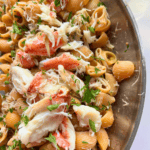

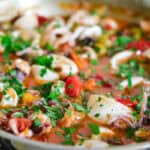
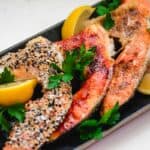
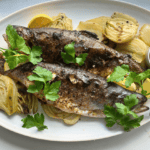
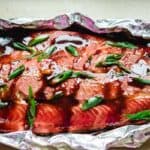
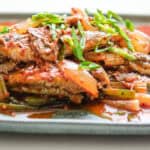


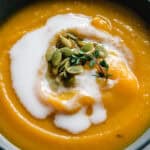
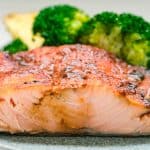







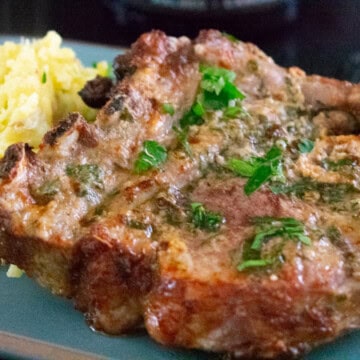
Leave a Reply